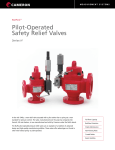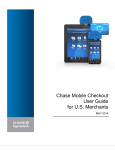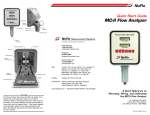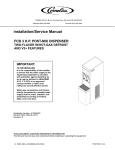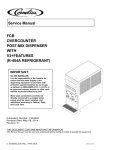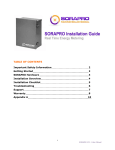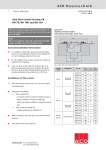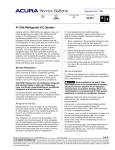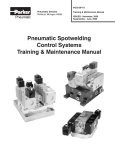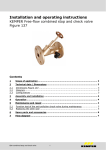Download Pilot-Operated Safety Relief Valves - Comsert
Transcript
MEASUREMENT SYSTEMS NUFLO™ Pilot-Operated Safety Relief Valves Series H In the mid 1940s, a new relief valve actuated with a pilot rather than a spring set a new standard for pressure control. The valve, manufactured over the years by companies like Garrett, USI and Axelson, is now manufactured and sold by NuFlo Measurement Systems. NuFlo's pilot-operated pressure relief valves are an example of a tradition of advanced design and high-quality manufacturing abilities. These valves offer advantages not found in other relief valves-spring- or pilot-operated. Full Flow Capacity Backflow Protection Simple Maintenance Non-Flowing Pilots Coated Bodies Easier Handling Valve Types Type HF Type HL This is a full lift, pop-action valve with a fixed (5% to 7%) blowdown using a single non-flowing pilot. This type of valve is designed for gas and/or vapor service and is offered in sizes of 1" through 8" with operating pressures ranging from 20 psig to 6000 psig. This is a modulating valve with a fixed (3% to 5%) blowdown using a single non-flowing pilot. This valve is designed for gas, vapor and/or liquid service and is offered in sizes of 1" through 8" with operating pressures ranging from 15 psig to 1500 psig. Advantages Features Full Flow Capacity Soft or Hard Seat Seals In addition to the various API orifice sizes, NuFlo offers valves with non-standard API orifice sizes for maximum flow capacity and smoother operation. Many times this allows for the use of smaller size valves at a cost savings to the customer. Soft or hard seat seals are available for a variety of service conditions and applications. Soft seat seals are recommended for discharge set pressures of 25 psi to 1500 psi. Hard seat seals are recommended for discharge set pressures above 1500 psi. Backflow Protection The unique NuFlo split piston (optional) is designed to eliminate the effect of pressure in the discharge system backflowing into a relief valve on installations where several valves discharge into a common manifold. Simple Maintenance Variable Flange Dimensions Flange dimensions can be modified on special order to fit most existing installations. This permits NuFlo pilot-operated safety relief valves to be used as replacements for older spring-loaded valves which may not conform to new safety standards. All maintenance, including changing the valve seat, can be performed using ordinary hand tools without removing the valve from the installation. In-Service Test Kit Non-Flowing Pilots Manual Blowdown NuFlo non-flowing pilots reduce the problems of “freeze-up” caused by the pressure drop through the flowing-type pilots. This optional device, which allows manual blowdown of the system, can also be controlled from a remote location. Coated Bodies Direct or Remote Control The bodies and piston housings of all NuFlo pilot-operated safety relief valves are internally and externally coated with Xylan® for corrosion protection and lubricity. Depending on the application, the operation of the NuFlo pilot-operated safety relief valve may be controlled directly from the point of installation or remotely. Easier Handling No “Simmer” A lifting eye is conveniently located on the center of the valve for ease of handling during installation or removal. NuFlo pilot-operated safety relief valves are designed to eliminate "simmer" at the valve seat. They do not require "percent accumulation" or over-pressure to operate. This optional feature allows checking or changing the pilot set pressure in the field with the valve in service. Special Flanges NuFlo pilot-operated safety relief valves can be supplied with special flanges such as Graylock, Taper-Lok, Lenz, etc. 2 MEASUREMENT SYSTEMS Advantages and Features NuFlo Pilot Operated HF HL Easy and economical to maintain All maintenance can be performed without removing valve from line Replaceable soft seat Saves costly lapping of valve seat Operates without simmer at valve seat Can be set close to system operating pressure. Unaffected by vibration of pulsation Block and bleed pilot as standard Reduces freeze-ups caused by pressure drop through flowing type pilots Accurate setting with small volume of pressure Test fixture available for fast accurate setting Backflow protection Prevents flow of gas back through valve when working on line Combines functions of blowdown and safety valves Saves cost of additional valves and piping Higher capacity per valve size Field test of pilot set pressure Set pressure can be checked or changed with valve still in service Can be used with solenoid valve For electric or pneumatic interface Coated internally and externally Bodies and piston housings. Xylan coated for corrosion protection and lubricity Balanced pilot Allows venting into discharge system without effect of back pressure Competitive Spring Loaded Valve Yes Yes No Yes Yes Yes Yes Yes No Yes Yes No Yes Yes No Yes Yes No Yes Yes No Yes Yes No No Yes No Yes Yes No Yes Yes No No Yes No Application A pilot-operated pressure relief valve, according to the 1992 ASME Code Section VIII, Division 1, Section UG-126, is a pressure relief valve in which the major relieving device is combined with, and is controlled by, a self-actuated auxiliary pressure relief valve. NuFlo pilot-operated pressure relief valves are designed to be used wherever there is a need to exhaust the overpressure volume of gas, vapor and/or liquid. Applications include oil and gas production systems, compressor stations, gas transmission (pipelines) facilities, storage systems, distribution systems and in all types of processing plants. Valve Operation NuFlo pilot-operated safety relief valves operate on the principle of unequal areas exposed to the same pressure. When the relief valve is closed, system pressure pushes upwards against the piston seat seal on an area equal to the inside diameter of the seat. Simultaneously, the same system pressure passes through the pilot, exerting a downward force on the piston acting on an area approximately 50% greater than the inside diameter of the seat. The resulting differential force holds the valve tightly closed. As the system pressure rises, the force against the piston seal increases. Then, when the system pressure reaches the relief valve discharge set pressure, the pilot cuts off system pressure and opens the top of the piston to vent pressure. As the pressure above the piston is relieved, the relief valve opens, discharging line pressure. When the predetermined blowdown pressure is reached, the pilot shuts off the exhaust and re-opens the flow of system pressure to the top of the piston, effectively closing the relief valve. 3 Operation Type HF Relief Valve Closed Type HF Relief Valve At below “set point”, the normally open combination pilot allows system pressure to enter the piston housing cavity of the relief valve on top of the free-floating piston. The top of the relief valve piston has a larger area than the valve seat where the piston seals. Equal pressure at both ends of the piston creates a differential downward force, which holds the piston tightly closed on the valve seat. (Fixed Blowdown 5-7%) Below: Type HF relief valve (closed position) Relief Valve Open When system pressure reaches the set point, the pilot piston is lifted off the valve seat. The blowdown seat seals off incoming line pressure, causing the exhaust port to open and bleed pressure from the relief valve piston cavity. Decreasing pressure on the top of the relief valve piston allows the valve to open, relieving system overpressure. As system pressure drops below the blowdown reset point, the blowdown seat opens, reseating the pilot piston, which causes the exhaust port to close. System pressure re-enters the relief valve piston cavity, closing the relief valve. Right: Type HF relief valve (relieving position) 4 MEASUREMENT SYSTEMS Operation Type HL Relief Valve Closed Type HL Relief Valve At below “set point,” the normally open Type HL pilot allows system pressure to enter the piston housing cavity of the relief valve on top of the free-floating piston. The top of the relief valve piston has a larger area than the valve seat where the piston seals. Equal pressure at both ends of the piston creates a differential downward force, which holds the piston tightly closed on the valve seat. Below: Type HL relief valve (closed position) Relief Valve Open When system pressure reaches the set point, the pilot piston forces the pilot stem upward by compressing the pilot valve spring. This movement of the stem simultaneously blocks the system pressure passageway through the pilot and commences the bleeding of pressure from the relief valve piston housing cavity. Decreasing pressure on the top of the relief valve piston allows system allows the valve to open, relieving system overpressure. As system pressure drops below the blowdown reset point, system pressure re-enters the relief valve piston cavity, closing the relief valve. Right: Type HL relief valve (relieving position) 5 In-Service Testing and Pilot-Setting Options All NuFlo pilot-operated pressure relief valves may be ordered with an In-Service Test Kit. The procedures for the use of this In-Service Kit are shown below. Type HF In-Service Testing of Pilot Set Pressure CAUTION: Never use oxygen as a pressure source. Pressure from a cylinder of nitrogen or some other pressure source (NOT OXYGEN) may be used to check the setting or to reset the pressure at which the relief valve will operate. 1. Connect pressure hose from nitrogen bottle to field test valve "A". 2. Close vent valve "B". 3. Open field test valve "A". 4. Slowly open block valve "C" permitting test pressure to increase to valve set point. 5. 6. 7. 8. Observe set pressure on test gauge and record. Close valves "A" and "C". Open vent valve "B". Disconnect pressure hose from field test valve "A". NOTE: For additional information on In-Service testing, refer to the service manual or technical data sheets for this product. When a relief valve is not equipped with the In-Service Test Kit, a Relief and Blowdown test fixture can be used to check or change valve set and blowdown pressures in field shops. Only the pilots need to be removed from the relief valve and it is not necessary to remove the valve itself from the installation. The operation of this portable test fixture is simple and convenient. CAUTION: Never use oxygen as a pressure source. Pressure from a cylinder of nitrogen or some other pressure source (NOT OXYGEN) may be used to check the setting or to reset the pressure at which the relief valve will operate. Special training is not required and complete instructions are furnished with each fixture. The test fixture may be ordered with optional needle valves and adapters for any type of pilot. Type HL Typical Direct Hook-Up with In-Service Test Valve (Gas Service Only) 1. Connect pressure hose from nitrogen bottle or hydraulic hand pump to test port of header block. 2. Close vent valve "A". 3. Slowly open block valve "B", or operate hydraulic hand pump, permitting test pressure to increase to valve set point. 4. Observe set pressure on test gauge and record. 5. Close valve "B", or release pressure on hand pump. 6. Open vent valve "A". 7. Disconnect pressure hose from test port. NOTE: For additional information on In-Service testing, refer to the service manual or technical data sheets for this product. 6 MEASUREMENT SYSTEMS Pilot Construction The Type HF pilot is a single combination control with a fixed blowdown for controlling relief valve opening and closing pressure set points. The opening set pressure is determined by the force of a control spring, which holds the relief control section of the valve closed. When system pressure acting on the relief control valve seat area equals the spring force, the relief control opens, and the blowdown control section closes, blocking system pressure from passing into the chamber above the main valve piston. As the relief control opens, the pressure underneath the control seat is exposed to a larger pressure area which provides “snap” action of the control pilot to quickly reduce pressure in the piston dome. This pressure reduction causes the main valve piston to lift, relieving system pressure. After the system pressure is reduced to a point whereby the control valve spring forces the blowdown control ball to unseat, the relief control valve closes, and the open blowdown control valve allows system pressure to re-enter the piston dome, forcing the main piston down to a closed valve position. The Type HL pilot is a single-control pilot with a fixed blowdown for controlling the opening and closing of the relief valve. Opening and closing pressures are determined by the force of a pilot control spring. System pressure is applied to the pilot control piston and also to the pilot inlet "Hi" port. The lifting force produced by the pressure on the control piston is reacted by the opposing force of the pilot spring. When the spring force is greater than the pressure force of the control piston, system pressure is communicated through the inlet "Hi" port of the pilot to the top of the relief valve piston. Since the area on top of the relief valve piston is greater than the seat area, the valve is held in the closed position. As pressure increases above the set point, the force of the control piston becomes greater than the reacting spring force. This unbalanced condition shifts the pilot stem upward, blocking the pressure coming into the inlet “Hi” port and allowing the pressure above the relief valve piston to bleed off. As the pressure force, (which holds the piston on the seat) decreases, the relief valve opens. If system pressure continues to rise, the piston lifts fully and remains open until system pressure is reduced sufficiently for the pilot spring to shift the pilot into its flowing position. Function of the Split Piston Normal Piston Position Split Piston Separated All NuFlo pilot-operated pressure relief valves can be ordered with the exclusive NuFlo split piston. This piston is designed to eliminate the effect of back-pressure imposed on the discharge side of the valve. The split piston is recommended for installations where a manifold discharge system serves a number of relief valves. If a manifolded relief valve is out of service when one or more other valves exhausts into the common discharge system, the split piston separates and prevents backflow through the out-of-service valve. 7 Installation Schematics Types HF Type HL Direct Hookup Relief valves configured for direct operation are equipped with an internal pressure pickup tube (stinger) in the throat of the valve inlet. They are factory shipped as selfcontained assemblies, ready for installation. Remote Hookup Relief valves configured for remote operation do not contain an integral pressure pickup connection. Pressure is sensed from a remote point on the vessel/process line through a single tube connected to the header block located on the valve. 8 MEASUREMENT SYSTEMS Orifice Selection Available Orifice Sizes for Type HF and HL Pilot-Operated Relief Valves Valve Coefficient: 0.859 (gas), 0.674 (liquid) Valve Size Outlet Orifice Orifice Area (Sq. In.) 1” x 2” Single D 0.110 1-1/2" x 2" 1-1/2" x 3" 2" x 3" Single Single Single Valve Size Outlet Orifice Orifice Area (Sq. In.) 3” x 4” Single J 1.287 E 0.196 K 1.838 F 0.307 L 2.853 G 0.503 M 3.600 GX 0.652 N 4.340 1” 0.785 P 6.380 D 0.110 3” 7.068 E 0.196 L 2.853 F 0.307 M 3.600 G 0.503 N 4.340 H 0.785 P 6.380 J 1.287 JX 1.633 1-1/2” G H 0.785 J 1.287 4” x 6" Single/Dual 4” 12.566 Q 11.045 1.767 R 16.000 0.503 T 26.000 6” x 8" 8” x 8" Single/Dual Dual 6” 28.270 Q 11.045 JX 1.633 R 16.000 1-1/2” 1.767 T 26.000 G 0.503 7” 38.484 H 0.785 7-1/2” 44.178 Q 11.045 R 16.000 J 1.287 JX 1.633 8” x 10" Single/Dual K 1.838 T 26.000 KX 2.776 7” 38.484 2” 3.141 7-1/2” 44.178 Trims Available Materials of Construction Standard Stainless Steel HF HL HF HL Body CS (1) CS (1) Piston Housing CS (1) CS (1) CS (1) CS (1) AL AL 316 SS 316 SS Valve Seat 316 SS 316 SS 316 SS 316 SS Orifice 316 SS 316 SS 316 SS 316 SS CS 316 SS CS 316 SS 316 SS 316 SS Piston Header Block Pilot Valve Notes: (1) A-216-Gr WCB (2) A-351-Gr-CF8M CS (1) Full Stainless Steel HF HL NACE HF HL SS (2) CS (1)(3) CS (1)(3) SS (2) SS (2) CS (1)(3) CS (1)(3) 316 SS 316 SS 316 SS 316 SS 316 SS 316 SS 316 SS 316 SS 316 SS 316 SS 316 SS 316 SS 316 SS 316 SS 316 SS CS (3) 316 SS 316 SS 316 SS 316 SS 316 SS 316 SS CS (1) SS (2) (3) HRc 22 maximum 9 Soft Seat Service Material Continuous Temperature, °F Maximum Minimum Minimum Pressure, psi Pilot Main Maximum Pressure, psi Pilot Main Buna-N 275 -65 15 15 6000 1500 Viton 400 -65 15 15 6000 1500 Teflon 400 -423 – 60 – 1500 Peek 480 -423 – 1500 – 3000 S.S. – – – 1500 – 6000 Sizing Order Form A relief valves primary purpose is to protect lives and property. It is imperative that the proper valve be selected for your application. To assure that the proper valve is selected, please fill out the Order or Sizing Order Form and consult your NuFlo representative for assistance. GENERAL INFORMATION Company Name Customer Name Date Tag Number Service Quantity INPUT DATA Specific Gravity/Mol. Weight Ratio of Specific Heats (K) Compressibility Factor (Z) Required Capacity Set Pressure Relief Temperature Allowable Overpressure Back Pressure Fluid Type & State OPTIONS Model Piston Type Hook-up Type Trim Seal Material Seat Type Other MISCELLANEOUS Additional Information 10 ■ HF (Snap Acting – 5% to 7% Fixed Blowdown) ■ HL (Modulating – 3% to 5% Fixed Blowdown) ■ Solid ■ Split (Back Flow Preventor) ■ Direct Sensing ■ Remote Sensing ■ Standard ■ Stainless Steel ■ NACE ■ Buna ■ Viton ■ Other ■ Soft ■ SS Hard ■ Peek ■ In-service Test Kit ■ Remote Unloader ■ Manual Blowdown Valve ■ Pilot Filter ■ Dome Spring ■ Teflon MEASUREMENT SYSTEMS Relief Valve Order Form GENERAL INFORMATION Company Name Customer Name Date Tag Number Service Quantity ISERVICE CONDITIONS Set Pressure Service Vessel Number Fluid Type & State VALVE SELECTION Model ■ HF (Snap Acting – 5% to 7% Fixed Blowdown) ■ HL (Modulating – 3% to 5% Fixed Blowdown) Part Number Inlet Size & Rating Outlet Size & Rating Orifice OPTIONS Piston Type Hook-up Type Trim Seal Material Seat Type Other ■ Solid ■ Split (Back Flow Preventor) ■ Direct Sensing ■ Remote Sensing ■ Standard ■ Stainless Steel ■ NACE ■ Buna ■ Viton ■ Other ■ Soft ■ SS Hard ■ Peek ■ In-service Test Kit ■ Remote Unloader ■ Manual Blowdown Valve ■ Pilot Filter ■ Dome Spring ■ Teflon MISCELLANEOUS Additional Information 11 MEASUREMENT SYSTEMS Xylan® is a registered trademark of Whitford Corporation MEASUREMENT SYSTEMS Formerly: NuFlo Measurement Systems • Barton Instrument Systems • Caldon, Inc. NORTH AMERICA ASIA PACIFIC EUROPE, MIDDLE EAST & AFRICA 1.800.654.3760 65.6737.0444 44.1243.826741 ms-us @ c-a-m.com [email protected] [email protected] Houston, TX • Corpus Christi, TX • Kilgore, TX • Odessa, TX • Dallas, TX • Tulsa, OK Duncan, OK • Denver, CO • Bakersfield, CA • Shreveport, LA • Lafayette, LA Houma, LA • Pittsburgh, PA • Laurel, MS • Dunbar, WV • Casper, WY • Charleston, WV USA: CANADA: Calgary, AB • Edmonton, AB Aberdeen, Scotland • Beijing, China • Bognor Regis, UK Dubai, UAE • Hassi Messaoud, Algeria • Kuala Lumpur, Malaysia • Singapore I N T E R N AT I O N A L : HOUSTON HEAD OFFICE: 281.582.9500 • www.c-a-m.com/flo RV-RVALVE NF00033 0701












